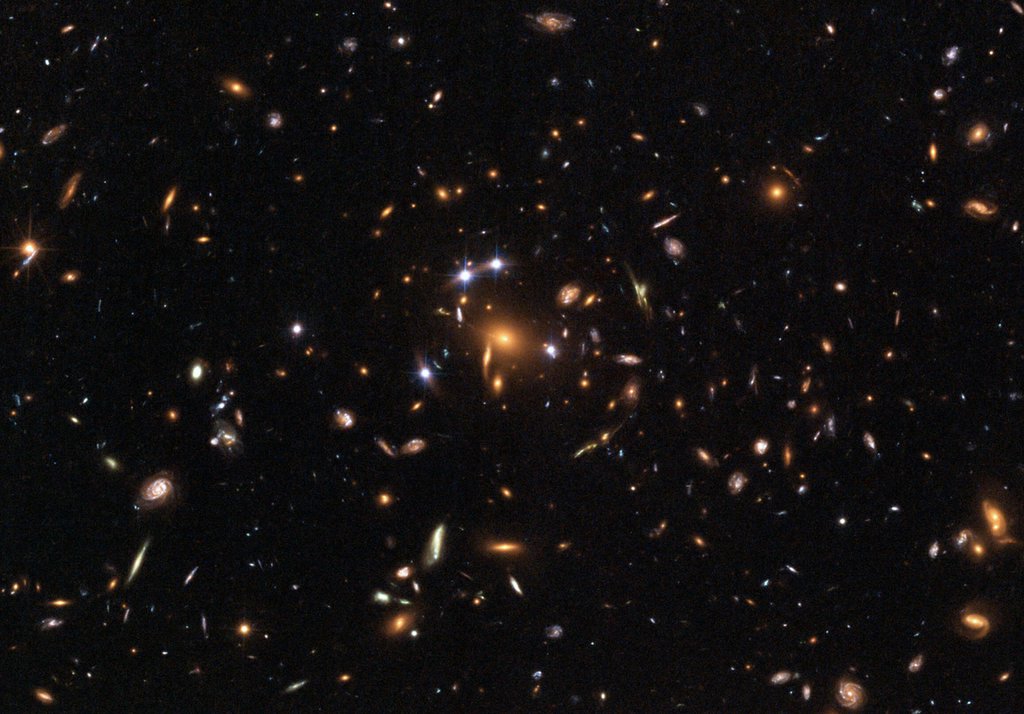Way back in 1979, astronomers spotted two nearly identical quasars that seemed close to each other in the sky. These so-called “Twin Quasars” are actually separate images of the same object. Even more intriguing: the light paths that created each image traveled through different parts of the cluster.
One path took a little longer than the other. That meant a flicker in one image of the quasar occurred 14 months later in the other. The reason? The cluster’s mass distribution formed a lens that distorted the light and drastically affected the two paths.
Fast-forward to 2022. A team of astronomers from the University of Valencia reported on their study of a similar effect with another distant quasar. They spent fourteen years measuring an even longer time delay between multiple images of their target quasar.
The galaxy cluster SDSS J1004+4112 plays a role in the delay. The combo of galaxies and dark matter in the cluster is really entangling the quasar light as it passes through. That’s causing the light to travel different trajectories through the gravitational lens.
The result is the same strange time-delayed effect. Hubble’s image of SDSS J1004+4112 with annotations showing the lensed images of the distant quasar, plus other lensed objects. “The four images of the quasar that we observe actually correspond to a single quasar whose light is curved on its path towards us by the gravitational field of the galaxy cluster”, said José Antonio Muñoz Lozano, professor of the Department of Astronomy and Astrophysics, and director of the Astronomical Observatory of the University of Valencia.
“Since the trajectory followed by the light rays to form each image is different, we observe them at different instants of time; in this case, we have to wait 6. 73 years for the signal we observed in the first image to be reproduced in the fourth one. ” The Sloan Digital Sky Survey first discovered cluster SDSS J1004+4112.
Hubble Space Telescope imaged it in 2006. It was the first image of a single quasar with its light split into five images by lensing. A Quick Graphical Guide to Lensing A Quasar Gravitational lensing creates an optical effect as light passes through a region of space with a strong gravitational influence.
How gravitational lensing causes light from a distant quasar to “detour” as it travels through a galaxy cluster. Courtesy NASA/ESA, K. Sharon (Tel Aviv University), E.
Ofek (CalTech). What Do Time Delays Tell Astronomers? The observed time delay dangles some interesting clues about lensing clusters in front of astronomers. Galaxy clusters are astonishingly massive and the largest gravitationally bound structures we know of in the universe.
Some contain thousands of galaxies. The combined gravity of the galaxies, plus the intermingled dark matter in the cluster can entangle light from more distant objects as it passes through or near the cluster. It turns out that the mass of all the “stuff” in the cluster is spread out unevenly.
That can affect the path of light through the cluster. So, astronomers need all the data they can get about the distribution of matter in a cluster. That includes dark matter.
It all helps them to understand how it affects the path of light from a distant quasar. “Measuring these time delays helps to better understand the properties of galaxies and clusters of galaxies, their mass, and its distribution, in addition to providing new data for the estimation of the Hubble constant,” Lozano said. Understanding Mass Distribution in Lensing Clusters In addition to the mass distribution, observational data also helps understand other characteristics of the lensing cluster, said Raquel Fores Toribio, a postdoctoral student at the University.
“In particular, it has been possible to constrain the distribution of dark matter in the inner region of the cluster, since the lensing effect is sensitive not only to ordinary matter but also to dark matter”, she said. She added that calculating the time delay also allows other discoveries, including the distribution of stars and other objects in the area of space between galaxies in the cluster. In addition, it will help astronomers to calculate the size of the distant quasar’s accretion disk.
A recently published paper describes the team’s use of new light curves for the four bright images of the SDSS J1004+4112 gravitational lensing system. The observations occurred over 14. 5 years at the 1.
2-meter telescope located at the Fred Lawrence Whipple Observatory (FLWO, USA), in collaboration with scientists at The Ohio State University (USA). For More Information The Longest Time Delay Ever Measured Between Multiple Images of a Quasar The Longest Delay: A 14. 5 yr Campaign to Determine the Third Time Delay in the Lensing Cluster SDSS J1004+4112 A Mass Model for the Lensing Cluster SDSS J1004+4112: Constraints from the Third Time Delay The post Gravity Really Tangled up the Light From a Distant Quasar appeared first on Universe Today.
.
From: universetoday
URL: https://www.universetoday.com/157770/gravity-really-tangled-up-the-light-from-a-distant-quasar/
